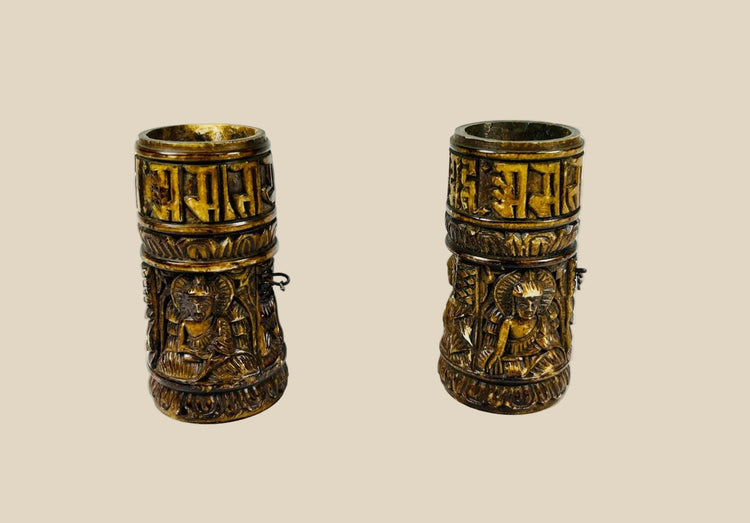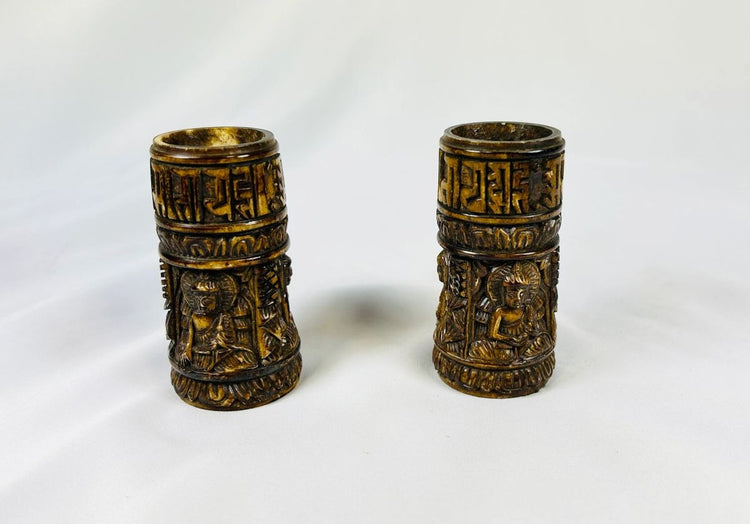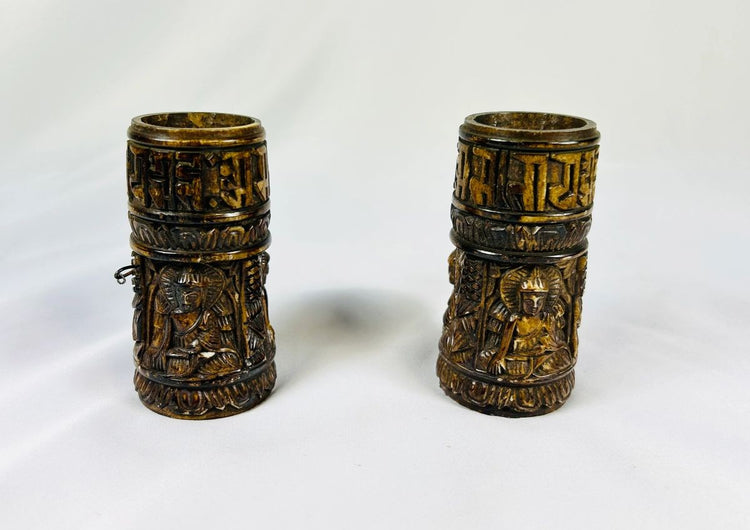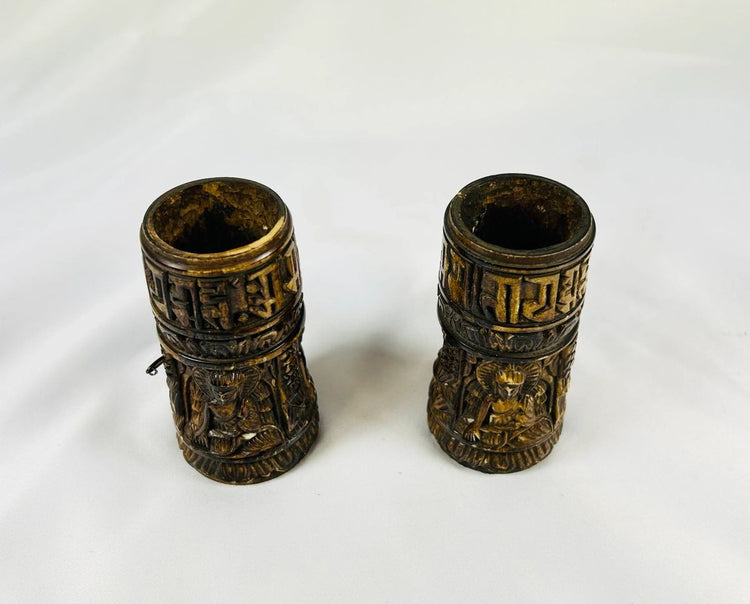Two Tibetan Thigh Bone Prayer Wheel Cylinders | 19th Century
Description
More
Less
Historical Context & Origin
Region: Tibet
Material: Human femur bone, hand-carved with relief decoration
Period: Likely 18th–19th Century (Tibetan Buddhist ritual tradition)
Description
This extraordinary and sacred pair of Tibetan Buddhist prayer wheels is intricately carved from human thigh bones, a practice deeply rooted in Tibetan ritual tradition. Measuring approximately 3.1 inches in height, each wheel is decorated with three relief-carved images of the Buddha in different mudra positions, beneath a band of Sanskrit prayers. Though compact in size, these objects carry immense spiritual weight, embodying impermanence, devotion, and the transformative power of Buddhist practice.
Features
- Pair of hand-carved prayer wheels from human femur bone
- Three Buddha figures in relief, each in a distinct mudra (hand gesture)
- Band of Sanskrit inscriptions symbolizing prayers and blessings
- Compact devotional size, 3.1 inches in height
- Crafted as ritual objects signifying impermanence and spiritual practice
Cultural Significance
In Tibetan Buddhism, prayer wheels are ritual tools believed to generate merit, spread compassion, and invoke blessings with each turn. Inscribed with sacred mantras such as Om Mani Padme Hum, these wheels serve as an extension of prayer itself—turning them has the same spiritual potency as vocal recitation. The use of human bone in sacred objects reinforces the Buddhist teaching of impermanence and the cycle of life and death. As such, these prayer wheels embody both ritual function and profound philosophical meaning, making them not only devotional objects but also testaments to the rich spiritual heritage of Tibet.
Condition
Good condition with natural age-related wear. Relief carvings and inscriptions remain clear and legible.
Dimensions (approximate)
Height: 3.1 in (each)
Age
18th–19th Century (Tibetan Buddhist tradition)
Learn More
Read About Tibetan Prayer Wheels
View Our Other Tibetan Artifacts: Tibetan Kapala Skull Cup, Pair of Rare Large Tibetan Kapala Citipati and Tibetan Tantric Ritual Apron (Rus Gyan)
Description
Historical Context & Origin
Region: Tibet
Material: Human femur bone, hand-carved with relief decoration
Period: Likely 18th–19th Century (Tibetan Buddhist ritual tradition)
Description
This extraordinary and sacred pair of Tibetan Buddhist prayer wheels is intricately carved from human thigh bones, a practice deeply rooted in Tibetan ritual tradition. Measuring approximately 3.1 inches in height, each wheel is decorated with three relief-carved images of the Buddha in different mudra positions, beneath a band of Sanskrit prayers. Though compact in size, these objects carry immense spiritual weight, embodying impermanence, devotion, and the transformative power of Buddhist practice.
Features
- Pair of hand-carved prayer wheels from human femur bone
- Three Buddha figures in relief, each in a distinct mudra (hand gesture)
- Band of Sanskrit inscriptions symbolizing prayers and blessings
- Compact devotional size, 3.1 inches in height
- Crafted as ritual objects signifying impermanence and spiritual practice
Cultural Significance
In Tibetan Buddhism, prayer wheels are ritual tools believed to generate merit, spread compassion, and invoke blessings with each turn. Inscribed with sacred mantras such as Om Mani Padme Hum, these wheels serve as an extension of prayer itself—turning them has the same spiritual potency as vocal recitation. The use of human bone in sacred objects reinforces the Buddhist teaching of impermanence and the cycle of life and death. As such, these prayer wheels embody both ritual function and profound philosophical meaning, making them not only devotional objects but also testaments to the rich spiritual heritage of Tibet.
Condition
Good condition with natural age-related wear. Relief carvings and inscriptions remain clear and legible.
Dimensions (approximate)
Height: 3.1 in (each)
Age
18th–19th Century (Tibetan Buddhist tradition)
Learn More
Read About Tibetan Prayer Wheels
View Our Other Tibetan Artifacts: Tibetan Kapala Skull Cup, Pair of Rare Large Tibetan Kapala Citipati and Tibetan Tantric Ritual Apron (Rus Gyan)
You May Also Like

















